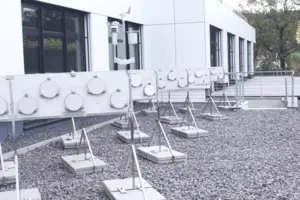
GREVEN INSIGHTS CONSTRUCTION: Outdoor Weathering
Oleochemical additives such as metallic and alkaline soaps are successfully used for the hydrophobization of building materials. To evaluate their effectiveness as hydrophobing agents, there are different test standards, including, for example, DIN EN ISO 15148, DIN EN 1015-18, ETAG 004 or DIN EN 1062-3.
At Peter Greven, we focus on examining the effectiveness of our products by particularly emphasizing water absorption according to DIN EN ISO 15148 and DIN EN 1015-18.
For DIN EN ISO 15148, hydrophobized fresh mortar is filled into disc-shaped molds with defined dimensions and tested for its capillary water absorption coefficient after 28 days of targeted storage. This coefficient indicates how much water a building material surface absorbs over a certain period and is relevant for assessing the effectiveness of hydrophobization and protection against moisture penetration.
Building materials, especially plasters and mortars, are no static systems. Therefore, it is important to consider chemical and physical processes such as setting time, hydration and carbonation, which can last longer than 28 days. Additionally, external environmental influences such as weathering, erosion, salt ingress, efflorescence and microbial infestation have an impact on the building material. All these processes alter the surface, potentially increasing strength and affecting capillary structure and water absorption.
To assess the durability of our hydrophobing agents, we conduct long-term outdoor weathering tests. According to DIN EN ISO 15148, manufactured disc-shaped test specimens are installed on a vertical structure without stress and subjected to direct weathering to simulate a plastered exterior wall. The fastening allows a gap of approximately 10 mm between the frame and the disc, avoiding the transfer of plasticizers or other substances. This also prevents changes in heat and moisture transfer.
The typical setup of our outdoor weathering series always includes a control specimen alongside the test specimens. This control specimen serves as a reference and represents a sample with the same mortar or plaster formulation but without hydrophobing agents.
We have already conducted various outdoor weathering series to investigate the durability of the products in different mortar systems over extended periods. The longest testing period so far has been eight years. A large weathering series with all our common hydrophobing agents has been running for six years but is planned to continue for up to 10 years.
The results so far show that our hydrophobing agents exhibit not only good performance but also high long-term stability, making them sustainable hydrophobing agents. They are not only weather-resistant and long-lasting but alsobased on natural, renewable raw materials and largely biodegradable.
In addition to our own research, we regularly collaborate with customers and design joint test setups for outdoor weathering at our headquarters in Bad Münstereifel. These tests are conducted in direct and close reconciliation, laying the foundation for successful cooperation. They enable the best possible evaluation of different products to find the right solution for a specific application and to present tailor-made solutions.
Our product manager Gabriel Kehren is at your disposal for any inquiries related to the construction sector.


